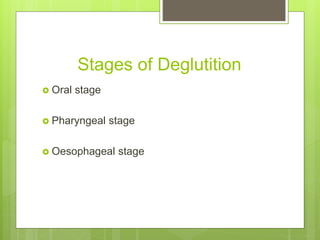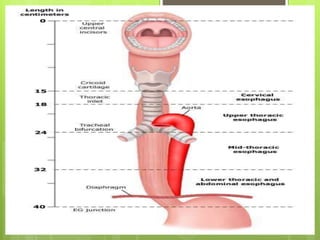Deglutition by Dr Anand More
- 1. Deglutition Dr Anand More Department of Physiology D.Y.Patil Medical College, Kolhapur
- 2. Deglutition The process by which swallowing of food is helped It also includes reflex action. Helped by movement of pharynx Closure of epiglottis to close larynx Upward movement of palate
- 3. Stages of Deglutition Oral stage Pharyngeal stage Oesophageal stage
- 6. Oral stage Orval stage is voluntary stage of deglutition. When food is ready for swallowing, bolus formed is put over the dorsum of the tongue. Tongue pressed against the palate and is moved backward, moving the bolus from mouth to pharynx
- 7. Pharyngeal stage When bolus moves from mouth to pharynx, receptors around opening of pharynx are stimulated, impulses from these areas pass to the brain stem deglutition centre to initiate series of muscular contraction. Soft palate moves upwards and close posterior nasal openings to prevent food into the nose.
- 8. Palatopharyngeal folds on either side of pharynx approximate to make a slit like opening so only properly masticated food can pass through.(Selective action) Vocal cords of larynx strongly approximate, larynx is pulled upward and anteriorly by neck muscles. Epiglottis swings backward to close laryngeal opening. This prevents entry of food in trachea. Upward movement of larynx enlarges opening of oesophagus. Pharyngo-oesophageal sphincter relaxes.
- 9. At the same time entire muscular wall of the pharynx contracts from superior to inferior part, originating a fast peristaltic wave which also continues in oesophagus. This wave pushes the food from pharynx to oesophagus.
- 11. Nervous control of Pharyngeal stage Pharyngeal stage of swallowing is a reflex. It is initiated by tactile stimulation in the area of opening of pharynx (especially tonsillar pillar which are very sensitive) Impulses are carried from these areas through 5th and 9th cranial nerves to medulla (deglutition centre). Efferent impulses from the centre pass through 5th, 9th, 10th and 12th cranial nerves to cause different sequential events in pharyngeal phase
- 12. Entire pharyngeal stage of swallowing lasts for 1-2 seconds. Pharynx is a common pathway for food and air. Therefore during pharyngeal stage airway above (nasal cavity) and below (trachea) is closed to prevent entry of food into respiratory passage. In addition, swallowing centre inhibits respiratory centre of the medulla to halt the respiration during any time in its cycle. The momentary stoppage of respiration is known as deglutition apnoea.
- 14. Oesophageal stage Oesophageal stage conducts food from oesophagus to stomach by movements as follows. Primary Peristalsis- It is simply continuation of peristaltic wave initiated in pharynx. It takes 8-10 seconds to carry food to stomach. But in upright posture food passes in the stomach earlier 5-8 sec because of gravity.
- 15. Secondary Peristalsis- If primary peristaltic wave fails to carry all the food to the stomach, secondary peristaltic wave is initiated in oesophagus due to distension of oesophagus with food. These waves continue till all the food entered is emptied into the stomach. These waves are produced due to intrinsic neural circuits in the wall and partly due to vagal reflex.
- 16. Types of muscle from oesophagus Musculature of pharynx and upper one third of oesophagus is formed of skeletal muscle whereas lower two third of oesophagus is formed of smooth muscles. Inner layer is circular muscle and outer layer is longitudinal muscle.
- 17. Clinical Significance Abolition of deglutition reflex - Causes regurgitation of food into nose or aspiration into larynx or trachea Aerophagia - Unavoidable swallowing of air along with food bolus and liquids. Usually occurs in nervous individuals. Partly the air absorbed is regurgitated in oral cavity (belching) majority passes as flatus.
- 18. Dysphagia - Difficulty in swallowing due to any cause. Cardiac achalasia - It’s a neuromuscular disorder of lower two third of oesophagus characterized by absence of peristalsis and failure of LES to relax Gastroesophageal reflux disease - It is condition in which incompetence of LES causes reflux of acidic gastric contents in oesophagus and causes heartburn.
- 19. Summary Stages of Deglutition Oral stage Pharyngeal stage Nervous control of Pharyngeal stage Oesophageal stage Types of muscle from oesophagus Clinical Significance
- 20. References Textbook of Medical Physiology – Guyton And Hall 13th Edition Textbook of Physiology – A K Jain 6th Edition Medical Physiology For Undergraduate Students – Indu Khurana Net Source for pictures & etc.



















